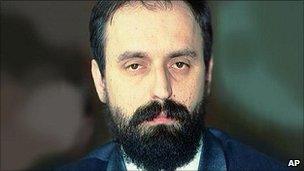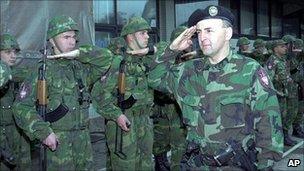Goran Hadzic: The last fugitive
- Published

Goran Hadzic, indicted in 2004, faces 14 counts of war crimes and crimes against humanity
Goran Hadzic, the last wanted Yugoslav war crimes suspect, has been arrested in Serbia after seven years on the run.
The BBC's Nick Thorpe recently visited Vukovar - the scene of a 1991 massacre for which Mr Hadzic is accused - and reports on a history of brutality and bloodshed.
The name of the agricultural company Goran Hadzic once worked for, VUPIK, still stands in proud letters over the former detention facility at Ovcara farm, near Vukovar.
This is where the most notorious crime for which he now stands accused was committed - the killing of more than 260 people taken from Vukovar hospital after it fell to Serb forces, after an 87-day siege in the autumn of 1991.
The site is now a centre of remembrance, with cartridge cases carefully embedded in the concrete floor of a farm building where some of the victims were bludgeoned to death.
Their faces light up, then fade in a high-tech display around the walls, while some of their personal belongings are arranged on the straw beneath their faces. In the middle of the room their names, projected in red light, spiral downwards until they disappear.

The former Vukovar hospital is now a centre of remembrance to the victims of the 1991 massacre
Outside, the farm carries on its normal activities all around, and the smell of the pigs - Ovcara was a pig farm at the time of the massacre - is almost overwhelming.
Mr Hadzic was a tall, bearded warehouse worker at VUPIK before he rose to political power as leader of the Croatian Serbs, at the time that Croatia broke away from Yugoslavia.
As the last of the 161 people indicted for war crimes by the Hague War Crimes Tribunal (ICTY) to be arrested, he also came to be seen as the last piece in the jigsaw puzzle of justice administered by the court.
After an early political career in the League of Communists, Mr Hadzic joined the Serbian Democratic Party (SDS), as a flood of new parties emerged from the one-party system.
He was elected chairman of the SDS in 1990, and as Croatian Serbs organised their resistance to Croatian independence, they were armed both by the Yugoslav army and by Serb irregulars and volunteers.
Many of the crimes for which Mr Hadzic now stands accused of criminal responsibility were carried out by the most notorious of the paramilitary leaders, Zeljko Raznatovic, known as Arkan.
By-word for terror
As a native of Vinkovci in eastern Slavonia, the eastern-most portion of Croatia, bordering on the River Danube, Mr Hadzic was in political control of Serbs in towns like Dalj, Vukovar, Erdut and Ilok.
This is where some of the fiercest fighting and most horrific crimes were committed in a war that cost more than 10,000 lives.

Arkan's men, the Tigers, rapidly became a byword for terror and brutality in the region
In June 1991, Mr Hadzic became president of the self-proclaimed Serbian Autonomous District of Slavonia, Baranja and Western Srem, and from February 1992 president of the whole Serbian Krajina region.
Arkan based his paramilitary "Tigers" beside a fuel depot at Erdut. The two men, Arkan and Mr Hadzic, were often seen in each other's company, according to media reports.
Arkan's men, armed and equipped by the Serbian police and army, rapidly became a byword for terror and brutality; murdering, raping and looting wherever they went, first in Croatia, then in Bosnia, then finally in Kosovo.
After the war, Mr Hadzic lived openly in the northern Serbian city of Novi Sad, until he was indicted by the ICTY in 2004. He then disappeared overnight, and despite several alleged sightings, remained elusive until now.
The Fruska Gora region where he was arrested is a beautiful range of hills, and the heartland of the Serbian Orthodox Church.
There are 17 working monasteries, which have gained a heightened importance for both the Church and the country, since the loss of Kosovo.
"The fact that the arrest has happened now is a political move by Serbia," said Kristijan Drobina, of the Ovcara memorial centre.
"Of course we are pleased, but we are afraid how this will end."
He mentions the case of Veselin Slivjancanin, a Serbian army officer also accused of responsibility for the Ovcara killings, who was released recently after serving three years of the five-year sentence he received from the Hague tribunal.
"That adds up to just eight days for each person who was killed here," said Mr Dobrina.
In nearby Vukovar, most of the houses, chewed apart by mortars and artillery during the siege 20 years ago, have been knocked down or repaired, though some have been left as mementos of the war.
The basement of the town hospital has been turned into another memorial to horrors of the siege. The last room is a chamber of mirrors, reflecting back a single red-lit cube in the centre, on which candles burn.
Preparations are at an advanced stage for the 20th anniversary of the siege, which lasted from August to November 1991.
- Published20 July 2011
- Published20 July 2011
- Published2 June 2011
- Published23 June 2011